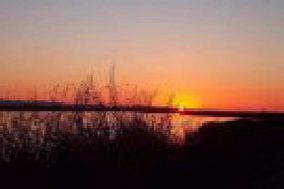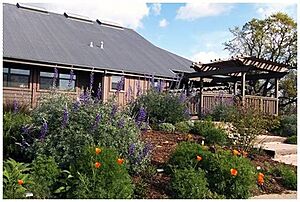Cosumnes River Preserve facts for kids
Quick facts for kids Cosumnes River Preserve |
|
|---|---|
|
IUCN Category V (Protected Landscape/Seascape)
|
|
 |
|
| Location | Sacramento County, California |
| Nearest city | Sacramento, California |
| Area | 46,000 acres (190 km2) |
| Established | 1987 |
| Governing body | Joint management-The Nature Conservancy, Bureau of Land Management, Ducks Unlimited, Department of Fish and Wildlife, Department of Water Resources, Sacramento County Department of Parks and Recreation, and the state Wildlife Conservation Board. |
| Designated: | 1976 |
The Cosumnes River Preserve is a special nature area in California. It covers about 46,000 acres (190 km2) of land. You can find it about 20 miles (30 km) south of Sacramento. This preserve protects a unique part of the Central Valley. Long ago, this area had huge forests of oak trees and wetlands.
The Cosumnes River is very special. It is the last big river in California's Central Valley that still flows freely. It doesn't have any large dams. The preserve is located where the river meets the Sacramento-San Joaquin Delta. This area is home to many different plants and animals. You can find three types of oak trees here. There are also rare plants like the northern California black walnut.
The preserve is famous for its birds. It's a key stop for sandhill cranes during their fall migration. More than 250 kinds of birds have been seen here. Over 40 types of fish and about 230 plant species also live in the preserve.
Because it's on the Pacific Flyway, a major bird migration route, the preserve is an Important Bird Area. This means it's super important for birds. Rare birds like the Tri-colored Blackbird and the Greater Sandhill Crane live here. Many birds that had disappeared from the Central Valley are now returning to the preserve.
The National Park Service started protecting this area in 1976. They called it the Cosumnes River Riparian Woodlands. This program helps save important natural places across the country.
The preserve owns about 46,000 acres. A large part of this land, almost 40,000 acres, is used for farming. The preserve uses both public and private lands. It provides a home for migrating birds all year. It also protects natural oak forests, wetlands, and grasslands. You might even spot threatened animals like the Elderberry longhorn beetle, California giant garter snake, and the Swainson's hawk here.
Contents
A Look Back: History of the Cosumnes River Preserve
Who Lived Here First? The Miwok People
Many centuries ago, the Miwok Native American tribe lived around the Cosumnes River. They were a large group, with about 9,000 Miwok people in 1770. They lived in small groups of 300 to 475 people. The Miwok ate acorns, seeds, deer, and fish. They used special methods, like controlled burning, to help the land grow more food. This also helped fish in the floodplains.
Changes to the Land: Spanish Settlers and the Gold Rush
Around 1770, Spanish explorers arrived. They thought the Central Valley was perfect for grazing animals. Later, in the early 1800s, fur trappers came. In 1844, the Mexican government started giving out land. John Sutter, a European immigrant, was one of the first to settle near the Cosumnes River.
When the California Gold Rush started in 1848, many miners came to the river. They hoped to find gold. When they didn't find much, they built dams. They changed the land to grow crops like hay, wheat, and fruit. This destroyed the Miwok people's food sources and villages. The Miwok eventually moved away from the area.
Saving the Valley Oaks: How the Preserve Began
In the 1980s, the valley oak tree was disappearing fast. The Nature Conservancy, a group that protects nature, wanted to save these trees. They looked all over the valley. The best oak forests were found along the lower Cosumnes River. So, in 1987, they created a preserve of 800 acres (3.2 km2).
Scientists soon learned how important the river was to the oak forests. Valley oaks, also called "swamp oaks," love the rich soil left by floods. The Conservancy realized they needed to protect a much larger area. They decided to protect the whole watershed, which is 1,200 square miles (3,100 km2).
They started working with farmers and government groups. These partners include the US Bureau of Land Management and the California Department of Fish and Wildlife. In 1998, the Conservancy bought the Howard Ranch, which had important wetlands. This helped expand the preserve.
Today, the preserve is over 46,000 acres (190 km2). It's one of the biggest efforts to restore a river and its surrounding lands. This project helps protect Central Valley habitats and wildlife.
The River's Role: How it Helps Nature
The Cosumnes River is special because it has no major dams. It flows for about 80 miles (130 km). When it rains heavily, the river floods. These floods bring in fresh soil and nutrients for plants. They also refill the underground water. Removing old levees (walls built to stop floods) helps the river flood naturally. This is called "natural process restoration."
Meet the Mighty Oaks
Two important trees in the preserve are the valley oak and the blue oak. The valley oak was once very common in central California. It's the largest native California oak tree. It can live for 600 years! Its roots can go as deep as 80 feet to find water.
The blue oak can handle dry soil. Its roots can go 30 feet deep. It has a unique blue tint to its leaves. Blue oaks can live for 400 years. They provide important winter food for deer and other animals.
Oak trees produce hundreds of pounds of acorns each year. Many animals, like deer and squirrels, eat these acorns. If there aren't enough acorns, it can affect how many animals survive.
Protecting the Trees: Challenges and Solutions
The trees face threats from land clearing, rodents, and non-native grasses. These non-native grasses grow fast and produce many seeds. This attracts animals like gophers, which also eat acorns and young oak trees.
To help, the preserve breaks down levees. This allows floodwaters to wash away the non-native grasses. It also reduces rodent numbers and brings in new soil. Studies show that floods help cottonwood and willow trees grow. These trees then trap more soil during the next floods.
The plants in the preserve, like oaks, willows, and cattails, provide food and homes for many animals. This includes birds migrating on the Pacific Flyway. The river's natural floods keep this amazing plant and animal life healthy.
Water Flow: The Hydrology of the Preserve
The Cosumnes River Preserve is a wetland area. It floods every year. In the past, underground water would rise to feed the preserve in late summer. But now, farming has used up much of this underground water. So, it can't refill the wetlands in early summer.
During the wet season (late fall to early spring), much of the preserve floods. This creates a perfect wetland home for many river plants and animals. In late summer and early fall, the Cosumnes River sometimes has no water flow. This can affect local water plants and fish.
Who Lives Here? Plants and Animals
Amazing Plants of the Preserve
Besides the famous Valley Oak, many other plants live here. Near the water, you'll find Cottonwood trees, cattails, and Broadleaf Arrowhead. Other plants include Wild California Grape, California Rose, and Elderberry trees. Unfortunately, two invasive plants, Perennial Pepperweed and Common water hyacinth, are also found here.
Wildlife Wonders: Mammals, Birds, Fish, and More
The Cosumnes River Preserve is home to many animals.
- Mammals: Larger mammals include beavers, otters, mountain lions, and black-tailed deer. Smaller ones are muskrats, black-tailed jackrabbits, and raccoons.
- Birds: You can see red-tailed hawks, swainson's hawks, and Nuttall's woodpeckers. Many migratory birds also visit. These include greater and lesser sandhill cranes, tundra swans, and various ducks.
- Fish: Two native fish species found here are Chinook salmon and Tule perch.
- Amphibians and Reptiles: Look for the California Tiger Salamander, the Giant Garter Snake, the Western Fence Lizard, and the Western Pond Turtle.
Visiting the Preserve: Fun and Learning
Explore the Visitor Center
The Cosumnes River Preserve Visitor Center is the main spot for all activities. They offer workshops, field trips, and learning materials for students and teachers.
Outdoor Adventures: What to Do
You can enjoy watching wildlife, paddling, taking photos, and studying nature. You can also do some fishing. There's a place to launch canoes or kayaks near the visitor center. You can get a map for a self-guided trip. The ocean's tides affect the river here, so water levels change daily. This shows mudflats and sandbars.
There are several waterways called "sloughs." Wood Duck Slough is to the east. It has amazing views of the "Tall Forest." Here, huge valley oaks hang over the water, creating deep shade. It's a beautiful, peaceful spot.
Hiking Trails and Driving Tours
The preserve has many hiking trails. Some are short walks to see wetland plants and animals. Others are longer, like the 7 miles (11 km) Howard Ranch trail. This trail takes you past vernal pools, river habitats, and offers views of oak woodlands and the Sierra Nevada Mountains.
There's also a driving tour. This lets you see the large size of the conservation project. It shows you areas that are not open to the public.
Get Involved: Volunteer Opportunities
The Cosumnes River Preserve needs volunteers! Volunteers help visitors learn about the plants and animals. They also help the staff with important work like restoring habitats and protecting the land.
Become a Volunteer Naturalist
If you want to help, you can become a Volunteer Naturalist. This training takes two days. You'll learn about the plants and animals, different volunteer jobs, and the groups that help the preserve.
Ways to Help Out
- Visitor Center: Many volunteers work at the visitor center, answering questions.
- Restoration Projects: You can help remove invasive plants or build wood duck boxes.
- Bird Surveys: Volunteers help count birds and raptors at least once a year. This helps estimate bird populations.
- Paddle Team: Join the paddle team to lead tours on the Cosumnes River. Some tours, like the bat paddle, let visitors see thousands of Mexican Free Tail bats feeding at sunset!
- Mountain Lion Research: This team gets to go into closed parts of the preserve. They set up cameras to watch mountain lions.
There are many other ways to volunteer and help protect this amazing place!



